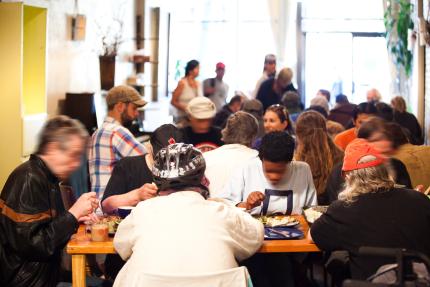Witness & With-ness

If you were to choose one biblical passage or phrase that summarizes Christian mission, what would it be?
Would it be Jesus’ commission to his followers in Matthew 28? ‘Therefore go and make disciples of all nations, baptizing them in the name of the Father and of the Son and of the Holy Spirit, and teaching them to obey everything I have commanded you. . . .’ Or maybe Jesus’ words of peace and sending from John 20? ‘Peace be upon you. As my Father has sent me, so I am sending you . . .’
Both worthy candidates! And of course there are many others that could make the list.
But I’d like to suggest one simple word as a summary of Christian mission: with.
In his book Incarnational Mission: Being With the World, theologian, pastor, and missioner Sam Wells asks us to consider the missiological implications of Jesus’ incarnation. Does it matter that Jesus – the son of God, fully divine and fully human, the Word-Made-Flesh – spent the first 30 years of his life simply being with the world? Before Jesus set about gathering disciples and beginning his public ministry of announcing and embodying his kingdom, and before Jesus’ defeated the powers of death and darkness through his crucifixion and resurrection, Jesus spent 30 years eating meals, learning carpentry, laughing with neighbours, and experiencing life in one small corner of God’s good but groaning creation. What do those 30 years have to teach us about mission?
Rather, I ask how I can be in relationship with, in solidarity with, the people or the place in front of me.
Sam Wells argues that those 30 years tell us that God wants to be with God’s creation and God’s creatures – especially human beings, God’s image-bearers. God’s incarnation in Jesus is God’s powerful word to the world: ‘I love you. I delight in you. I want to be with you.’
If that is true, then the word ‘with’ is not just a simple conjunction but a theme that is close to God’s heart – and close to the heart of Christian mission.
Through my work with mission-minded students, community partners, and global allies, I’ve started to see just how important this ‘with-ness’ really is. Whether I am teaching students to wrestle with the gospel call to justice and peacemaking, partnering with local grassroots groups to address issues of poverty and trauma in our neighbourhoods, or visiting a poverty alleviation project in southern Honduras, I always try to ask myself: how can I be with this person or community?
This means that I do not first ask what I can for this community, this person, this landscape. Rather, I ask how I can be in relationship with, in solidarity with, the people or the place in front of me. What would a genuinely mutual, shared relationship with this person ask of me?
‘Being with’ doesn’t just reshape the starting point of mission. It also reshapes mission’s goal, and so reshapes its practice. I now resist asking: what do I want this person, community, or place to end up like? Instead, I try to ask: what would a relationship of mutual joy, celebration, and delight look like in this time and place, with this people – and how does my prayer, action, and life-together need to change now as a result?
This is not to say, of course, that witnessing to God’s kingdom and the power of God’s death and resurrection are not integral to Christian mission. But let’s not forget to commit to ‘with-ness’ as we witness: to be with the people and places of God’s world, in much the way that God was with us in Jesus.
Don't miss a blog in our (International) Mission Postures series. Read and subscribe for each piece in the series.
Photo provided by the author.



